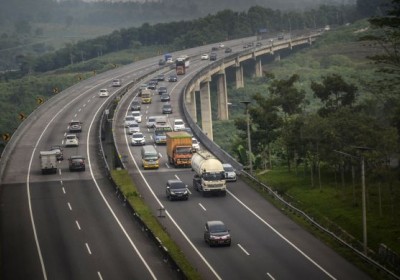Returning Home This Year’s Eid al-Fitr Runs Smoothly Thanks to Improved Infrastructure
June 13, 2018
ANTARA FOTO/Raisan Al Farisi
“Departing from Kuningan (West Java) at 5 am, reaching Kediri (East Java) at 2.30 pm. Alhamdulillah (Praise to God) going smoothly plus really fast. Thanks for new toll road that can be used #ceritamudik2018,” wrote Ajeng, a housewife, in her Facebook account on 9 June 2018.
A number of new toll roads have been operational to help travellers experiencing smoother traffic prior to this year’s Eid al-Fitr. Travellers using cars pack Trans Java, Trans Sumatera, Trans Kalimantan and even Trans Sulawesi toll roads.
Transportation Ministry predicts this year’s returning home trip flow is more crowded compared to last year’s. The rise is probably due to improved infrastructures, either in Java or outside Java islands, such as toll roads in Java North Coast route, Trans Sumatera, Trans Sulawesi and other infrastructures.
As taken from Katadata, the number of travellers returning home by car rises by 16%, by two-wheeled vehicles soars by 33%. On the other hand, travellers going back home by sea transportation mode and train is predicted to rise by 2%. The addition will also occur in air transportation which goes up by 9%. The number of travellers going to the eastern part of Indonesia is also predicted to up by 16%.
“Undeniably, looking at the air transportation, public purchasing power gets better,” said Transportation Minister Budi Karya as quoted from KataData, in the middle of May.
Information as taken from Setkab.go.id, connected infrastructure development has been pioneered since 2015. In 2015, there are 1,286 km of streets that are just built. A year later, the government establishes 559 km of roads. And in 2017, 778 km of roads are set up. Thus, the total of the new roads is 2,623 km.
In 2018, the government is targeting building 1,071 km of new roads and another 1,120 km will be developed in 2019. Therefore, the total of the new roads development under the leadership of Jokowi-JK will amount 4,814 km.
Apart from public streets, 568 km new toll roads have been built which is divided into 132 km in 2015 and 44 km in 2016. The remaining 392 km will be set up this year. Jokowi is even targeting toll road development will reach 1,851 km until 2019.
Starting from 2015 until early 2018, the government has built 25,149 meters of bridges. Up to 2019, the government is targeting building bridges as far as 29,859 meters. As a result, connectivity facilities are better thus making it easier for people mobility from Java Island to other islands.
Infrastructures are not only for travellers
Infrastructure development doesn’t only bring benefit for travellers but also overcome gap, put economy growth at same level and spur new economic centers. As taken from Setkab.go.id, President Jokowi talked about the importance of developing infrastructure aggressively by the government in forms of toll roads in Java or outside Java, building new airports, enlarging existing airports and improving existing big, small or medium ports.
He cited Kuala Tanjung Port in North Sumatera as an example. Tanjung Priok port is also expanded to accommodate ships of any size docking at the port. New ports are also set up in Makassar New Port until Sorong, Papua, to create spaces for big ships to dock at them.
Furthermore, the President said the development process was carried out in small ports, such as Tapaleo port, Central Halmahera. H said the small port was needed to carry cement, staple foods, rice, sugar, from and to the port. Corns, secondary crops, nutmegs, and the like are taken out to be sold to other islands.
“This is what I frequently call as sea toll, connecting (and) linking inter-island, inter-province, inter-regency, inter-city in our country Indonesia,” President Jokowi said in the middle of April 2018.
Development in skirt and border areas is accelerated to stimulate new economic spots. In addition, the eastern part of Indonesia holds a special focus to reduce inter-region gap.
Since the 1997 crisis, gap in Indonesia is worse compared to other countries. About 80% growth occurs in the western side of Indonesia. The more we go to the east of the country, the smaller economic contribution from the regions there to the national economy. Even an island’s welfare is completely left behind if compared to the welfare of Jakarta Capital Special Territory. For instance, Papua and Nusa Tenggara that have the highest gap despite the fact that the eastern sides of Indonesia have rich natural resources and potential culture diversity.
Besides inter-region, the gap also happens among urban and rural regions. Both have unequal basic service quality in spite of its crucial role for public economic productivity and social welfare.
In response to this, the National Development and Planning Agency holds Indonesia Development Forum 2018 under a theme of ‘Pathways to Tackle Regional Disparities Across the Archipelago’. IDF 2018 is supported by the Australian Government through Knowledge which aims at promoting development acceleration in Indonesia to be more equal and more sustainable based on knowledge, experience and fact.**
Indonesia’s Research Institutions Supporting the Development of the Electric Vehicle Industry
Indonesian Muslim Fashion and Cosmetics IKMs Shine at Dubai World Expo 2020
Govt Steps Up UMKM Transformation Efforts in the Midst of Pandemic Slowdown
Govt Encourages Promotion of IKM Products in Digital Era
Government Begins Developing Maritime Training Center in Makassar
Tweets by IDDevForum
